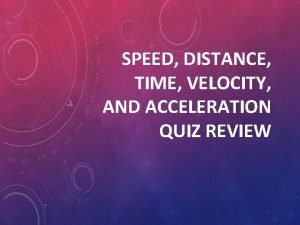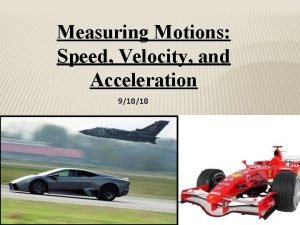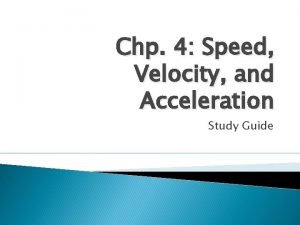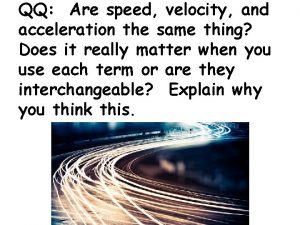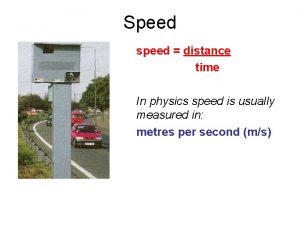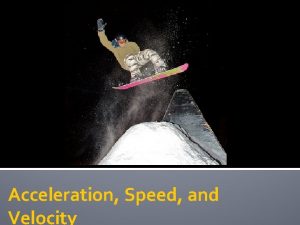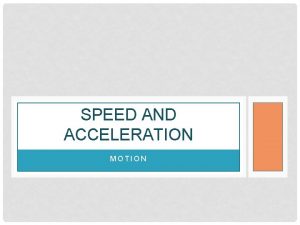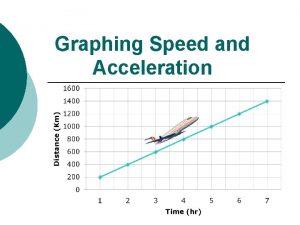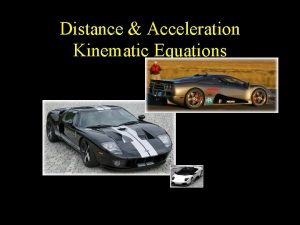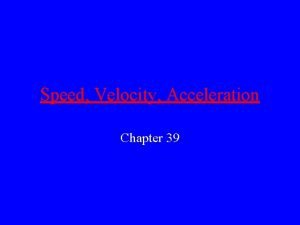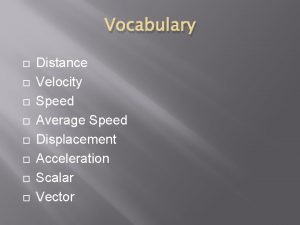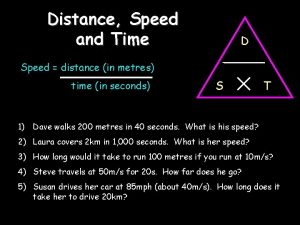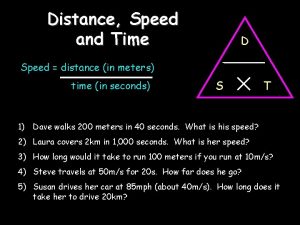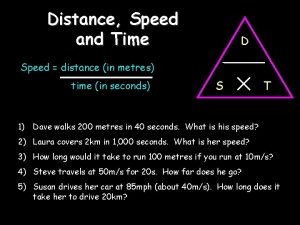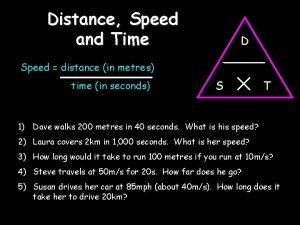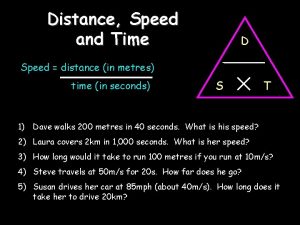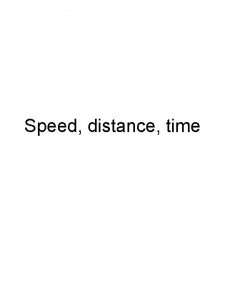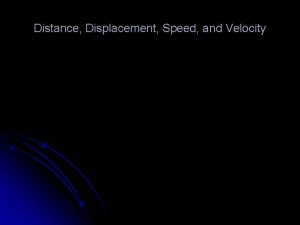Distance Speed and Acceleration Special Rates of Change


















- Slides: 18

Distance, Speed and Acceleration Special Rates of Change

Displacement, Velocity and Acceleration Special Rates of Change

What is to be learned? n How rates of change apply to displacement, velocity and time.

Displacement Distance (in a certain direction) x Velocity Change in displacement over a period of time (some call it speed!) v = dx/ dt Acceleration Change in velocity over a period of time a= dv/ dt

Ex An object is moving along x axis (cm) at time t(secs) according to equation: x = 4 t 2 + 10 t - t 3 Calculate: a) Displacement, Velocity and Acceleration after 1 second and 3 seconds b) Displacement and Velocity after 5 seconds

x = 4 t 2 + 10 t - t 3 displacement t=1 x = 4(1)2 + 10(1) – 13 = 13 cm velocity v = dx/dt = 8 t + 10 – 3 t 2 t=1 v = 8(1) + 10 – 3(1)2 = 15 cm/sec

x = 4 t 2 + 10 t - t 3 velocity v = dx/dt = 8 t + 10 – 3 t 2 t=1 v = 8(1) + 10 – 3(1)2 = 15 cm/sec acceleration a = dv/dt = 8 – 6 t t=1 a = 8 – 6(1) = 2 cm/sec 2

x = 4 t 2 + 10 t - t 3 displacement t=3 x = 4(3)2 + 10(3) – 33 = 39 cm velocity v = dx/dt = 8 t + 10 – 3 t 2 t=3 v = 8(3) + 10 – 3(3)2 = 7 cm/sec

x = 4 t 2 + 10 t - t 3 velocity v = dx/dt = 8 t + 10 – 3 t 2 t=3 v = 8(3) + 10 – 3(3)2 = 7 cm/sec acceleration a = dv/dt = 8 – 6 t t=3 a = 8 – 6(3) = -10 cm/sec 2

x = 4 t 2 + 10 t - t 3 velocity v = dx/dt = 8 t + 10 – 3 t 2 t=3 v = 8(3) + 10 – 3(3)2 = 7 cm/sec acceleration a = dv/dt = 8 – 6 t t=3 a = 8 – 6(3) = -10 cm/sec 2 It is decelerating

x = 4 t 2 + 10 t - t 3 displacement t=5 x = 4(5)2 + 10(5) – 53 = 25 cm velocity v = dx/dt = 8 t + 10 – 3 t 2 t=5 v = 8(5) + 10 – 3(5)2 = -25 cm/sec

x = 4 t 2 + 10 t - t 3 displacement t=5 x = 4(5)2 + 10(5) – 53 = 25 cm velocity v = dx/dt = 8 t + 10 – 3 t 2 t=5 v = 8(5) + 10 – 3(5)2 = -25 cm/sec It has changed direction

Motion and Derivatives Displacement Distance (in a certain direction) x (or h) Velocity (some call it speed!) Change in displacement over a period of time dx dh v= /dt (0 r /dt) Acceleration Change in velocity over a period of time a= dv/ dt

Ex Belinda throws a ball into the air Its height (h m) after t secs is: h = 4 t – t 2 Find a) Its height, velocity and acceleration after 1 sec b) What is its height when the velocity is zero?

h = 4 t – t 2 height (displacement) t=1 h = 4(1) – 12 = 3 m velocity v = dh/dt = 4 – 2 t t=1 v = 4 – 2(1) = 2 m/sec

h = 4 t – t 2 velocity v = dh/dt = 4 – 2 t t=1 v = 4 – 2(1) = 2 m/sec acceleration a = dv/dt = -2 t = 1 (or whatever!) a = -2 m/sec 2 decelerating by 2 m/sec 2

b) Velocity zero? v = dh/dt = 4 – 2 t = 0 4 = 2 t t=2 velocity is 0 m/sec after 2 seconds height? h = 4 t – t 2 t = 2 h = 4(2) – 22 =4 m

Graphical explanation v=0 h h = 4 t – t 2 4 3 1 2 t
 Time speed and distance formula
Time speed and distance formula Time distance/speed formula
Time distance/speed formula Is a ratio a rate
Is a ratio a rate Equivalent ratios definition
Equivalent ratios definition Ratios rates and unit rates
Ratios rates and unit rates Ratios rates and unit rates
Ratios rates and unit rates Relation between angular and linear quantities
Relation between angular and linear quantities Angular acceleration and linear acceleration
Angular acceleration and linear acceleration Tangential acceleration and centripetal acceleration
Tangential acceleration and centripetal acceleration Centripetal acceleration vs centripetal force
Centripetal acceleration vs centripetal force Radial acceleration definition
Radial acceleration definition Speed, velocity and acceleration quiz
Speed, velocity and acceleration quiz Speed velocity and acceleration problems answers
Speed velocity and acceleration problems answers How is velocity different from speed
How is velocity different from speed Speed velocity and acceleration formulas
Speed velocity and acceleration formulas Speed velocity and acceleration study guide answers
Speed velocity and acceleration study guide answers Are speed and acceleration the same thing
Are speed and acceleration the same thing What is acceleration
What is acceleration Velocity notes
Velocity notes











